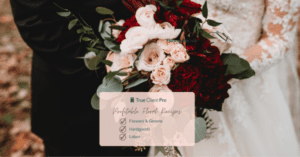When it comes to floristry, there are two main ways to learn the trade – formally trained or self-taught. Both have their pros and cons, but which one is right for you? Here’s a closer look at both options so you can make the best decision for your career.
The Benefits of Floristry Formal Training:
For anyone considering a career in the florist trade, formal education can be a great asset. While it is possible to learn the basics of flower arranging through trial and error, attending a professional school or program can give you the opportunity to learn from experienced instructors and gain access to specialized equipment and resources. In addition, formal training can help you develop the creative eye and technical skills needed to succeed in this competitive field. For one, education can help to develop an eye for detail and aesthetics. A good education will also cover the care and handling of flowers, as well as the use of different tools and techniques. In addition, education can provide helpful tips on how to start and run a successful business. Whether you’re looking to start your own business or find employment at a floral shop, possessing a degree or certification from a reputable program can give you the added edge you need to stand out from the competition.
The Disadvantages of Floristry Formal Training:
One of the main disadvantages of formal training in floristry is that it can be quite expensive. Education costs money, whether you are paying for tuition, materials, or other associated fees. Classes can be costly, and if you’re unable to get a scholarship or financial aid, it can be tough to justify the expense.
In addition, many floristry programs require students to complete an internship before graduating, which can also add to the cost. Another disadvantage of formal training is that it can take up much time. Many programs require students to complete several hours of hands-on training per week, attend classes, and study for exams. This can make managing challenging if you have other commitments such as work or family.
Another downside is that you may not get the opportunity to learn from the best instructors. Not all schools have equally qualified instructors, so it’s essential to do your research before enrolling in a program. Finally, another downside of formal education is that it may not always be necessary. If you have a natural talent for floral design and are familiar with the basics, you may be able to get by without any formal training.
Many successful florists have learned through experience and trial and error. So, if you’re considering a career in floristry, weigh the pros and cons of formal education before deciding.
The Benefits of Being a Self-Taught Florist:
One of the great things about being a self-taught florist is that there are many ways to learn the trade. There are online classes, books, and workshops available to help you hone your skills. And, if you’re willing to put in the time and effort, you can learn a lot on your own. The beauty of being self-taught is that you can learn at your own pace and tailor your education to your specific interests.
One advantage is that self-taught florists can learn at their own pace and choose which areas they would like to focus on. They are not limited to a specific curriculum and can instead explore different techniques and styles at their own discretion. Another benefit is that self-taught florists can be more creative in their designs since the rules and conventions of formal education do not bind them.
This allows them to experiment with new ideas and create unique arrangements that stand out from the rest. For example, if you’re passionate about weddings, you can focus on learning design techniques that will help you create beautiful bouquets and arrangements for your clients. Or, if you’re interested in event planning, you can learn how to choose the right flowers for large-scale occasions.
There are endless possibilities for self-taught florists who are willing to explore them. Finally, self-taught florists often have a more entrepreneurial spirit since they have taken the initiative to learn the trade on their own. This can be extremely beneficial when starting one’s own business or marketing oneself as a freelancer. Overall, there are many benefits to being a self-taught florist, and those who choose this path often go on to find great success in the industry.
The Disadvantages of Being a Self-Taught Florist:
A self-taught florist may have the passion and drive to succeed in the field, but there are some disadvantages to not receiving education from a trade school or florist program. One of the biggest disadvantages is the lack of industry connections. Trade schools and programs typically have relationships with local flower shops, meaning that graduates are more likely to be hired.
In addition, education provides students with the opportunity to learn from experienced professionals. They can offer guidance and advice on everything from starting a business to creating arrangements. Without formal training, it can be difficult to learn the proper techniques for creating beautiful arrangements.
Additionally, self-taught florists may not be familiar with the wide variety of flowers and plants available, and as a result, their arrangements may be less varied and innovative. Furthermore, customers may be less likely to trust the services of a self-taught florist, as they may perceive them as being less professional.
Finally, without the support of colleagues or mentors, self-taught florists may find it more difficult to stay motivated and creative. Finally, education can help students hone their skills and become more knowledgeable about the different types of plants and flowers available. Although there are some challenges to being a self-taught florist, it is still possible to create beautiful arrangements with time, patience, and practice.
So, should you get a formal education in floristry? That’s up to you. Do your research and talk to professionals in the field. See if there are any apprentice or mentorship programs available in your area. Ask yourself how much money you want to spend and what type of learning environment you prefer.
There are many options for both formal and self-taught florists, so it really depends on what works best for you. We hope this article has provided some information about the pros and cons of each option and given you something to think about as you decide on your career path.
Click HERE to see how True Client Pro can help you!



